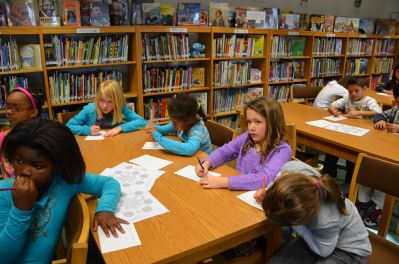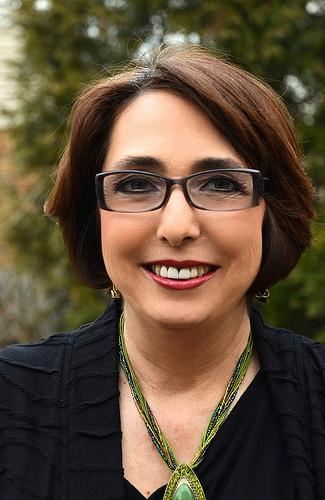Teaching for Learning: Assessment for Learning
Update December 2020:
This web page is a companion to the 2016 version of the School Library Program Rubric. NYSED released an updated School Library Program Rubric in December 2020.
Student Snapshot: Student learning is assessed in the library media program in collaboration with classroom teachers, utilizing data analysis and standards.
Stiggins et al. (2007) states that assessment for student learning happens while learning is still underway. These are the assessments that we can conduct throughout teaching and learning to diagnose student needs, plan our next steps in instruction, provide students with feedback they can use to improve the quality of their work, and help students see and feel in control of their journey to success. Each one reveals to students increments of achievement and how to do better next time. On these occasions, the grading function is laid aside. This is not about accountability - these are assessments of learning.
Source: Stiggins, Richard J, Judith A. Arter, Jan Chappuis, and Stephen Chappuis. Classroom Assessment for Student Learning: Doing It Right -- Using It Well. Pearson Education, Inc., 2007.
Citation for the Photo: Mattirolo, Chiara. USAG Livorno School. 2012. Livorno Unit School. Flickr.
This web page features a photo from Chiara Mattirolo, available under Creative Commons Attribution 2.0 Generic license.
In Practice
The Data Driven Library Program
Description: The Onondaga-Cortland-Madison Board of Cooperative Educational Services (OCM BOCES) School Library System (SLS) envisioned using student assessment data as a powerful tool for librarians to use to leverage their program in addressing student learning needs. BOCES' goal was to develop a pilot program known as Partners in Achievement: Library and Students (PALS), Improving Student Achievement through Data Use for Library Media Specialists service. The focus of PALS was to glean student achievement data from state assessments to inform and enhance library collections and collaborations with classroom teachers and to plan units of instruction to address identified student learning needs.
Resource/Citation: Dzikowski, Judith, Mary Tiedemann, and Justin Ashworth. "The Data Driven Library Program." Library Media Connection, 2010.
Authentic Assessment Toolbox Home Page
Description: The Authentic Assessment Toolbox, is a how-to text on creating authentic tasks, rubrics, and standards for measuring and improving student learning. Inside you will find chapters on standards, tasks, rubrics, portfolios and tests.
Resource/Citation: Mueller, Jon. "Authentic Assessment Toolbox Home Page." Authentic Assessment Toolbox, 2014.
Interactive Rubrics as Assessment for Learning
Description: This blog post explores one educator’s experiences using rubrics to enhance her lessons. In the article, readers will learn how she incorporated the interactive rubric into her lesson and how it impacted student’s learning.
Resource/Citation: Lampinen, Michelle. "Interactive Rubrics as Assessment for Learning." Edutopia, Dec. 2013.
TRAILS: Tools for Real Time Assessment of Information Literacy Skills
Description: “TRAILS is a knowledge assessment with multiple-choice questions targeting a variety of information literacy skills based on 3rd, 6th, 9th, and 12th grade standards. This Web-based system was developed to provide an easily accessible and flexible tool for school librarians and teachers to identify strengths and weaknesses in the information-seeking skills of their students. The assessment items are based on the American Association of School Librarians' Standards for the 21st-Century Learner and those from the Common Core State Standards Initiative that have been adopted by most states.There is no charge for using TRAILS.”
Resource/Citation: TRAILS. "TRAILS: Tools for Real Time Assessment of Information Literacy Skills." TRAILS.
Library Girl's Picks: The Best Digital Tools for Formative Assessment
Description: Jennifer LaGarde, Lead School Library Media Coordinator/Digital Teaching and Learning Specialist for New Hanover County Schools, shares the best digital tools for formative assessments. Included are examples of graphic organizers, polls and surveys, and individual whiteboards.
Resource/Citation: LaGarde, Jennifer. “Library Girl’s Picks: The Best Digital Tools for Formative Assessment”. The Adventures of Library Girl, 3 Dec. 2012.
The School Librarian’s Role in the Capstone Project
Description: Little reviews data that supports the importance of assigning a capstone project, reviews the capstone process and indicates the integral role of the librarian in design and implementation. Included is information on collaboration between high school and university librarians.
Resource/Citation: Little, Hannah Byrd. "The School Librarian’s Role in the Capstone Project." Knowledge Quest Blog, 2 Feb. 2016.
Goodbye, Boring Database Instruction. Hello, Search App Smackdown!
Description: Librarians are keenly aware of the value of teaching students to use databases. But has your “tried-and-true” instructional approach to these resources become “tired-and-boring?” If so, flip your instruction into a Search App Smackdown! This fun, challenging, and competitive gaming approach meets the American Association of School Librarians’ 21st-Century Learning Standards, skillfully integrating technology and standards by putting kids in the driver’s seat.
Resource/Citation: Boyer, Brenda. “Goodbye, Boring Database Instruction. Hello, Search App Smackdown!” School Library Journal, 2016.
In Theory
Assessment: A 21st Century Skills Implementation Guide
Description: In the 21st century, students must be supported in mastering both content and skills. This Implementation Guide presents state leaders, policymakers and/or district and school leaders with assessment tactics and examples to assist in statewide 21st century skills initiatives.The Partnership for 21st Century Skills has issued five brief, user-friendly guides, one for each of the P21 support systems.
Resource/Citation: Partnership for 21st Century Skills. "Assessment: A 21st Century Skills Implementation Guide". Partnership for 21st Century Skills, 2009.
Early Elementary Assessment
Description: This compilation of resources from the NYS Education Department guides educators - including librarians - in developing thoughtful and meaningful assessments, with the goal of gathering information for decision-making with the minimum assessment possible.
Resource/Citation: New York State Education Department. "Early Elementary Assessments." EngageNY, 21 Nov. 2013.
Checking for Understanding: Key Assessment for Learning Techniques
Description: When we check all students’ levels of understanding throughout each lesson, it sets the tone that everyone’s thinking is important and necessary, and we forward the learning and engagement of all. Some techniques are too time-consuming to use as quick pulse checks, but using these key techniques together in all lessons allows us to track learning and adapt instruction appropriately on the spot.
Resource/Citation: Newman, L., and S. Flaherty. "Checking for Understanding: Key Assessment for Learning Techniques." EngageNY, Sept. 2012.
Student Learning Objectives
Description: NYSED has compiled over 35 resources for educators on developing and implementing meaningful student learning objectives, which can be used in designing assessments. The page includes a video aimed specifically at librarians that covers their challenges and options when creating student learning objectives, and suggests topics to consider.
Resource/Citation: New York State Education Department. "Student Learning Objectives." EngageNY, 22 Oct. 2012.
The Empire State Information Fluency Continuum
Description: The ESIFC emphasizes the importance of inquiry in learning and establishes information fluency standards for grades K-12, which are aligned with Common Core Learning Standards. The fusion of the two sets of standards aims to create students who are capable of absorbing and applying appropriate information to any situation. The document identifies three information literacy standards which encourage students to be thinkers, explorers, and citizens and outlines the essential steps of inquiry: connect, wonder, investigate, construct, express, and reflect. The continuum also includes grade-specific benchmarks for information skill development and sample diagrams and worksheets which may be used to assess students’ progress. Finally,there is a helpful chart for administrators, teachers, and librarians that links progress along the fluency continuum with various Common Core Learning Standards in reading, writing, and speaking & listening. The continuum helps apply Common Core Learning Standards to real-world classroom teaching and is a great resource to use for grade-specific lesson planning.
Resource/Citation: New York City School Library System. “The Empire State Information Fluency Continuum”. Engage NY, 7 Nov. 2014.
Understanding Formative Assessment: Insights from Learning Theory and Measurement Theory
Description: This paper explores formative assessment, a process intended to yield information about student learning—information that teachers can use to shape instruction to meet students’ needs and that students can use to better understand and advance their learning. This purpose—promoting learning by informing instruction—distinguishes it from other kinds of student assessment, such as diagnostic, which is used to identify students who have special learning needs, or summative, which is used by teachers to form final judgments about what students have learned by the end of a course, or is used at the state level for the purpose of evaluating schools.
Resource/Citation: Trumbull, Elise, and Andrea Lash. “Understanding formative assessment: Insights from learning theory and measurement theory.” WestEd, 2013.
Education Testing: Assessment OF Learning versus Assessment FOR Learning
Description: This blog article briefly and clearly explains the distinctions between assessment OF learning and assessment FOR learning, and suggests that the goal would be “assessment AS learning – a process where students are aware of their own learning objectives, where they take responsibility for meeting those objectives, and where teachers assist students in their individualized learning paths. (An added benefit of assessment as learning is that it can be used to help students self-reflect on their behavior and attitudes as well as their learning.)”
Citation: Siedlecki, Joe. "Education Testing: Assessment OF Learning versus Assessment FOR Learning." Michael Susan Dell Foundation, 10 May 2012.
Using Common Formative Assessments to Check for Understanding
Description: “When teachers in course-alike groups or grade-level teams meet on a regular basis to look at student work, checking for understanding becomes a system wide process. … [They] explore the ways that teacher teams can use assessment information to guide their instructional interventions. [They] also describe ways in which teachers can use common formative assessments to increase their expectations, tune the curriculum, and inform instruction.”
Citation: Fisher, Douglas, and Nancy Frey. “Using Common Formative Assessments to Check for Understanding”. Checking for Understanding: Formative Assessment Techniques for Your Classroom. ASCD, 2014.
Consultant
Name: Ellen Frank Bayer
Email: ebayer@schools.nyc.gov, readingbeaver@gmail.com.
Bio: Ellen Frank Bayer is the certified library media specialist at Flushing High School in Queens, New York. She is the Region II Rep. for the NYLA, Section of School Librarians. She is also a book reviewer for VOYA magazine and a media reviewer for School Library Journal. She has won numerous grants for her library and is continuously looking for ways to inspire her students to become lifelong learners.
*To access restricted database articles speak with your school librarian or public librarian.







